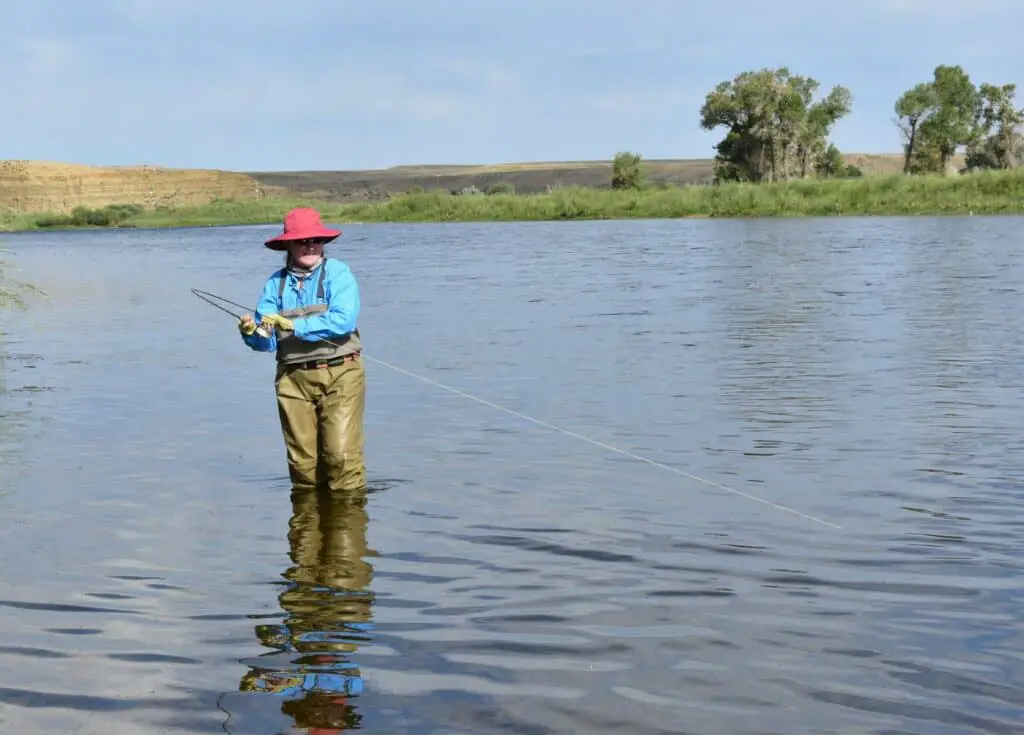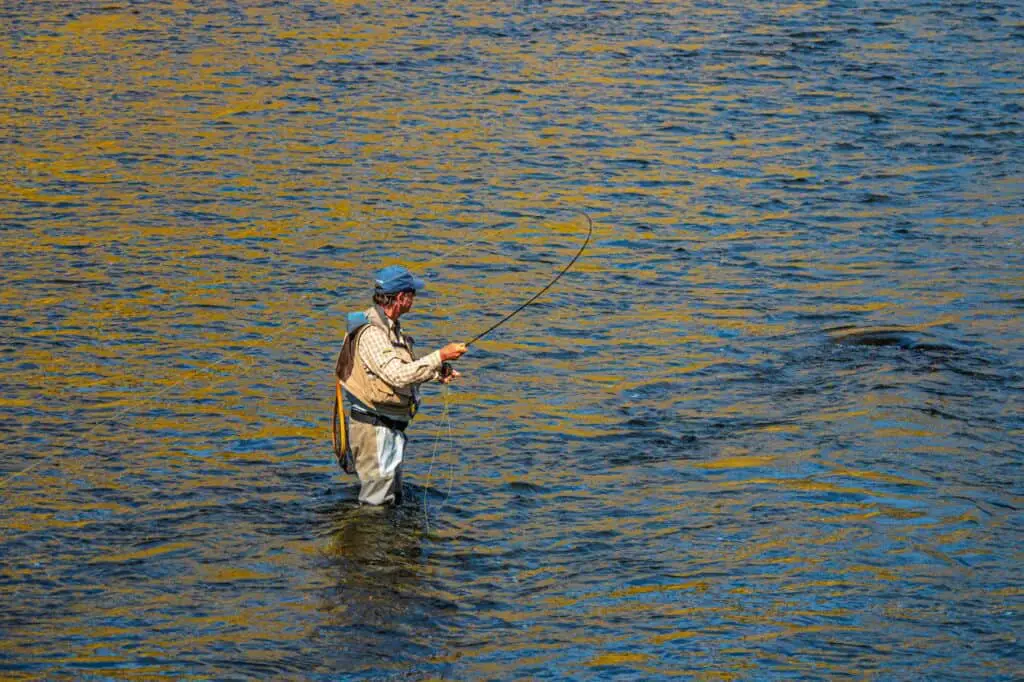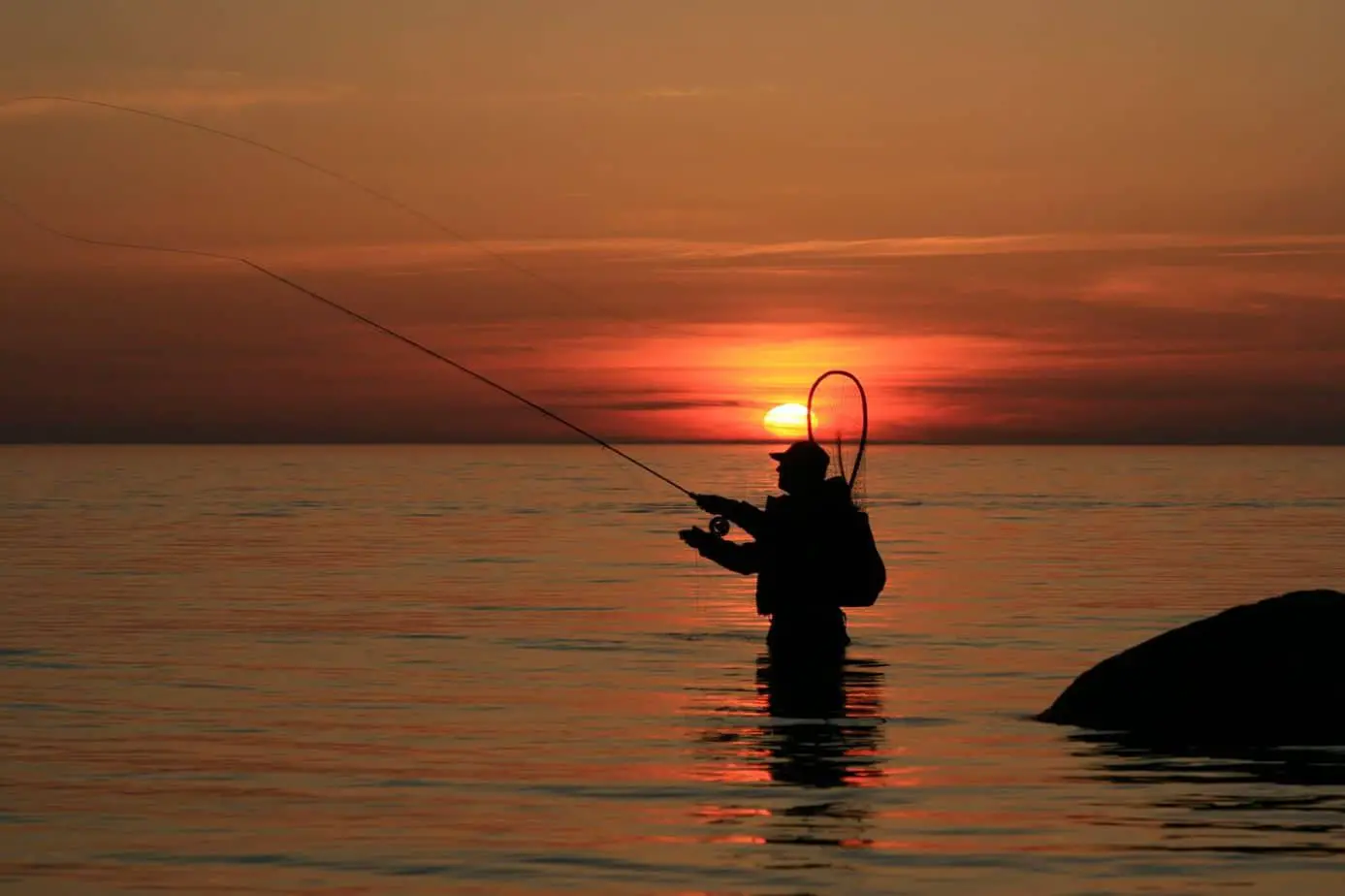The first fly fishing practices are believed to have been developed in Japan over four centuries ago. You’ll also hear some industry experts giving credit to Claudius Aelianus, who described a similar method that happened along the Astraeus River in Macedonia.
William Radcliff went even further into history, saying that Marcus Valerius Martialis developed the practices two hundred years earlier.
Although the inventor of fly fishing is up for debate, the Japanese style of Ayu fishing has thorough documentation. It originated in the island chain’s mountains to help provide meals to inn guests and extra income at the markets.
The processes used to catch fish then are similar to what they are now. Ayu fishing involves using a long rod, a lure that mimics a fly, and no specific casting technique. The first lures were made with bent needles that could hook a fish that swallowed the bait.
What Are the Top Myths About Fly Fishing?
You’ll get plenty of advice (some of it unsolicited) from the local fly fishing experts in every community.
Some of it is excellent, such as learning how to change your presentation periodically so that you can keep your lure light on the water.
The other stuff is sometimes forgettable, such as the superstition about bringing bananas with you as a snack.
If you want to get to know fly fishing better so that you can maximize your investment in this sport and hobby, here are the myths and misconceptions you’ll want to discard.
1. You need to use bigger lures to catch those big fish.
Although it seems like this statement would be true, it goes against basic predator-prey behavior. If you have a hungry fish, it’s going to snap up the fly you cast at your favorite river or body of water.
Some anglers might argue that you won’t catch smaller fish with bigger lures. That statement is relatively true. If you have a massive articulated streamer, you probably won’t be bringing in something that barely hits the minimum keeper measurements.
When you start fishing for those bigger keepers, placement is more important than size to your experience. If you let that fly land realistically on the water’s surface, a hungry fish will snap it up if it notices the event. You’ll see that rod start to bend and get some pull weight right away.
It is also quite fun to spot a big fish taking that small lure you cast on the water. Since it happens relatively often, once you get your preferred technique right, you’ll see why fly fishing is lots of fun!
Here are some of the best small lure kits that can deliver significant results.
Magreel Fly Fishing Kit
- Uses lifelike patterns and movement to generate attention.
- All of the lures are handmade.
- You receive four different types in this kit.
Ventures Fly Co. Lure Set
- Allows you to match the hatch when desirable.
- Offers 122 hand-tied flies from today’s fishing experts.
- Comes with reference cards to identify what insects are currently hatching.
YZD Panfish Flies Fly Kit
- Provides an alternative option for targeting panfish.
- Impressive durability for ongoing fly fishing opportunities.
- Fly hooks penetrate securely to ensure an accurate hold occurs.
2. The best time to start fishing is right after dawn.
You’ll hear many anglers say that the best time to go fly fishing is right after dawn. That statement isn’t 100% wrong. When you get up early in the morning to get to the water, you’ll find that the first rays of daybreak can deliver impressive results.
When you hear someone tell you that the only time to get trout, bass, or your preferred species is in the morning, it’s time to think about why you’re getting the advice.
Fish feed when they have an available food source. That means the water temperature is a better guide to follow than where the sun is (or isn’t) in the sky.
If you’re fishing in the summer, warm river waters can provide abundant opportunities throughout the entire day.
When you decide to try fly fishing, it’s often better to go out before seeing the other anglers hitting the water. If you come later, the fish might not be in the mood to bite – assuming there is any left to find!
Want to know more? Read “When is Fly Fishing Best?”
3. It is expensive to get the gear needed for fly fishing.
Fly fishing can get expensive when you purchase custom gear. If you hunt for deals on name-brand items and start learning how to make flies at home, you’ll find the costs can stay under control.
The one place where you shouldn’t compromise on the cost of fly fishing is on your core setup. If you get a basic rod, reel, line, and leader combination, you can expect to pay around $150 for those items.
It also helps to have a fly box, some nippers, floatants, and hemostats. You don’t need to invest in waders or some of the other clothing or apparel options until you’re ready to take your fishing game to the next level.
Although basic fly fishing gear works well for beginners, you’ll find it doesn’t take long to outgrow that investment. It’s better to put in as much money as you can at the beginning of the journey with the understanding that you’re committing to the process.
If you’re unsure that you’ll like it, try renting or borrowing equipment for the first couple of times you head to the water. That’s much cheaper and easier than putting a down payment on everything else.
Want to learn more? Read “Is Fly Fishing Expensive?”

4. Brook trout can get fished like any other trout species.
When you start fishing for trout as a beginner, you might not be pursuing that species. That’s why it is essential to know what fish you’re chasing.
Although river trout (browns and rainbows) are found in many fly fishing locations, several species called “trout” are actually char. That means you’re not getting a bull trout or a lake trout per se, which means your fly should be more appropriate to the char instead.
When you start fishing for char, you’ll find that the water temperatures tend to be a little colder in the places you’ll find success.
Trout only have black spots, while char have multiple colors to help them blend into numerous environments. Even posts that talk about fishing for trout are giving you advice about getting char instead.
The char species tend to react well to dry flies. You can also use streamers, spoons, and spinners to have a successful day on the water.
Trout are closely related to char, but they respond better to replications of soft-bodied bait. That’s because their primary diet is flies and other insects. You’ll get less reaction with spoons and some spinners unless the reflection looks lifelike.
Read “What Can I Catch By Fly Fishing?” to learn more about what you can catch with a fly rod.
5. You can only go fly fishing in rivers or streams.
Fly fishing can happen anywhere. If you get up in the morning early enough on Washington’s islands that sit west of Seattle, you can find anglers along the shore using their gear to fetch the ocean’s bounty.
Although fly fishing is often thought of as a freshwater activity, you can have lots of success with saltwater locations. Read, “Is Saltwater Fly Fishing Different From Freshwater?”
If you don’t live near the ocean, you can take your gear to a local lake to do some fly fishing. Any water that moves, including rivers, lakes, and streams, are also places where you can have some fun.
What about ponds? For the sake of this post, let’s just call them “small lakes.”
During your fly fishing expeditions, you’ll discover that many anglers prefer streams and shallow rivers because of the environment more than the fishing. Who can blame them? If you’re alone in the mountains while wading in a gentle brook, you’re already having fun. That means catching something is a bonus!
When you want to bring home a meal, an empty lake is usually better than a busy river.
We expanded on this in “Can You Fly Fish Anywhere?”
6. Most freshwater fish don’t respond to fly fishing.
It would be more accurate to say that “most freshwater fish don’t respond well to poor fly fishing techniques.” Although most anglers have a nose for trout (or char), they often forget about the other species that could take the bait.
Panfish, bass, and almost any other species that feed at the water’s surface will take your bait if you land it right. Even if the fish isn’t hungry, a flick of the wrist can trigger the prey instinct to activate.
Instead of bringing flies and other lures that only work for trout, take the entire kit with you for the experience. You’ll find that you can get plenty of bites pursuing something else when everyone is fishing for one species.
7. Wild fish found in rivers are the same as native fish.
It’s not unusual to hear people tell you that the native fish in the area are biting well. That’s different than a wild fish.
Although the difference is minor, it’s still a vital distinguishment for anglers. A native fish is a local species born and raised in a hatchery, while a wild one was part of the natural life cycle.
When you compare native fish with wild ones, you’ll find the colors tend to be brighter on the latter. They also look healthier with a side-by-side view, and the rigors of fending for yourself create a tastier bounty.
Brook trout are wild in the west and typically native in the east. If you fish for most rainbow trout in the United States, you’re pursuing a native species.
There aren’t any wild brown trout available In the U.S. to catch.
Why is there such a distinction, even though different generations could be born in the wild? A fish is still considered “native” if the species were transplanted there by human activities.
8. Fish have a short attention span.
It’s been said that a fish has a five-second attention span. Researchers even say that goldfish have a more extended focus period than humans.
Although you can certainly override a fish’s memory by triggering its prey instinct, this idea is undoubtedly a myth. If you’ve ever tried to fish somewhere that receives a lot of fly fishing pressure, you might never get a bite on your line.
When you go somewhere that receives minimal attention, you might have 40 keepers on your stringer when coming back.
This fact applies to the lure used when fishing in addition to your location. When the same fish see a similar fly cast every day, you might not get as much action as you would with something new.
That’s why it is always wise to take the advice of the local anglers with a grain of salt. You might want to try their recommendation, but don’t be afraid to switch to something you like better when there isn’t any action happening.
If you see someone fishing in a specific area, try to give them at least 50 feet of space. When there’s only you and them to worry about at a mountain stream, 200 yards should be the minimum spacing you offer.
If you’re looking for the best local advice, read “Should I Hire A Fly Fishing Guide?”

9. When you match the hatch, you can guarantee your results.
Matching the hatch refers to using a similar lure to the insects that start reproducing at that time of year. If there’s a prolific population by the water, you can theoretically snag a massive haul.
The keyword in that phrase is “theoretically.” Although some anglers say that matching the hatch guarantees a result, we know that there aren’t 100% absolutes with any fishing style.
Your technique, lure quality, and the fish’s personality all play roles in how easy (or difficult) it is to land a big one.
Although trying to watch the insects that you see coming off the water is an excellent idea, you’ll need to do more than match the prey type to go home happy. Working on your presentation is a better determiner of the results you can achieve.
Don’t forget about reading the water, achieving smooth drifts, and finding those hidden spots where some species like to strike.
To learn more, read “Different Types of Fly Fishing Flies.”
10. Practicing catch-and-release is harmless to the environment.
When you catch a fish that doesn’t meet the biome’s legal standard, regulations require you to return it alive to the stream. It is an often encouraged practice when you’re out there for sport instead of hunger.
If a particular biomass struggles to thrive, it could be illegal to keep specific fish of any size. Wardens often patrol the rivers, lakes, and streams carefully when these rules are in effect to protect the environment.
When you have lakes or streams over-run with non-native fish, catching one of these species might mean you’re forced to keep it.
Catch-and-release processes aren’t always perfect, which means they can sometimes adversely affect the environment. Several factors are outside of your control, including how the fish gets hooked to your fly. When water temperatures are too high, and the handling method goes wrong, you might be killing that fish you just released.
When you start fly fishing, we highly recommend that you practice your catch-and-release methodology to respect the population and the individual to keep damage to a minimum level.
11. You can only use flies when you are fly fishing.
When you start fly fishing, you might hear the advice that this lure is the only kind you can use. You’ll listen to debates about whether to use feathers, fur, hair, or synthetic materials because everyone has had successful experiences with each one.
Curious about wet and dry flies? Read “What Is The Difference Between Wet Flies And Dry Flies?”
Outside of dry or wet flies when casting a line, here are some other options to consider.
| Streamers: | This option resembles a baitfish instead of an insect. You’d use it to trail behind an underwater lure or jig, on a dripper, or fished from the line. |
| Nymphs: | When you try to match the hatch, this option lets you replicate an insect’s larval stage. They should sink after making your presentation. |
| Keel Flies: | You would use this option when you must work with weedless solutions. It has a bent shank down the line towards the hook to help create more consistency. |
| Ultralights: | This option is technically a plastic fly. They can replicate worms, minnows, crickets, ants, and other local bait options. It may be illegal to use them, so please remember to check with local rules. |
| Poppers: | Fly-rod poppers work well for bass fishing. They’re typically made of a spongy material, such as cork, to imitate how adult insects land on the water’s surface. Some options let you replicate frogs or mice. |
Are You Ready to Try Fly Fishing?
Although some fly fishing misconceptions have roots in reality, most myths evolve into something that detracts from the experience.
The best way to learn how to cast a line properly is to experiment with the techniques you prefer. Having different rods and equipment supports can let you know what combination works best for your preferences.
You can also find flies to buy, but part of the fun of fly fishing is to learn how to make them at home!
And if you haven’t figured it out yet, fly fishing is a little addictive. Learn why, here “Why Is Fly Fishing So Addictive?”


